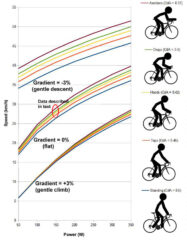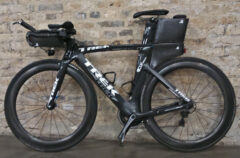Even on a relatively mountainous route, air resistance has a larger effect on overall cycling speed than weight / gravitational resistance. So how can the air resistance of the cyclist be minimized?

Page Contents:
- Method, Finish Times & Effects of Increasing Power on Cycling Speed
- Types of Resistance When Cycling
- How Air Resistance of the Bike & Equipment Affects Cycling Speed
Introduction
On the Types of Resistance page, air resistance was shown to account for 43-57% of a typical cyclist’s total resistance on different routes with weight only accounting for 38 or 24% of the total resistance, respectively.
The expected average speed on the 2016 Transcontinental Race (TCR) route is reasonably slow (under 22 km/h) and the extra weight of equipment being carried for a self-supported race means that the total weight of the bike and equipment is fairly high (the total weight of the bike and equipment is assumed to be 18 kg). Most people therefore question how air resistance can be an important factor in such situations. This video by Specialized attempts to explain this:
Out of all the air resistance holding a cyclist back, around 75-80% is due to the rider’s body on a typical road bike and only 20-25% is due to the bike. Although extra accessories, bags, etc. on a typical TCR bike will make it slightly less aerodynamic, the more comfort-oriented riding position used by most TCR riders means that their body tends to be less aerodynamic than that of an average road cyclist. The proportion of air resistance caused by each aspect is therefore likely to be similar, meaning that the body is the first thing to consider for aerodynamics.
Air resistance is the most difficult variable to measure of all of those that affect cycling speeds. In addition, different protocols of measuring air resistance can yield quite different results and the results often vary based on what other equipment is also present. I therefore keep these results very general and the values given on this page should be considered to be even less precise than those on the other pages in this section.
Method
Air resistance is typically measured as CdA, which is a combination of the shape of an object (i.e., a brick vs. a teardrop, which is measured by the drag coefficient, Cd) and its surface area (A). In the standard model used here, the average CdA of a typical bikepacker with a loaded bike and on a flat section of road is assumed to be 0.4. A slightly higher value (0.43) is assumed when climbing and a lower value (0.37) when descending due to the cyclist adopting different riding positions. See the General Method page for more information.
Rough estimates of how much different equipment choices affect air resistance are available on sites such as Aeroweenie and in the Specialized Win Tunnel videos. The results are typically given in seconds saved during a flat 40 km time trial. I have used these values to estimate changes in the CdA values to use in the model of cycling speed.
This BikeRadar article gives a good introduction of ways to estimate/measure CdA values for certain position or equipment setups.
Results & Discussion
For the estimated range of CdA values and the riding speeds of most bikepackers, a change in CdA of 0.01 translates into about 1 hour 5 minutes of cycling time saved across the 3900 km long route of the 2016 Transcontinental Race (TCR) and an overall speed change of about 0.13 km/h. Because the 2015 TCR route was flatter and longer, a change in CdA of 0.01 translates into a predicted change of about 1 hour 15 minutes on that route. These values are similar for the average-strength and strong riders, despite the difference in speed (which is a finding that is explained in this video).
Clothing & Body Hair

The easiest aspect to change regarding a cyclist’s aerodynamics is clothing. Using a tight, form-fitting jersey compared to a loose, relaxed-fitting jersey can reduce CdA by about 0.02, or about 2 hours of cycling time saved on the 2016 TCR route (or 4 hours difference in the predicted finishing time). A full aero’ skinsuit may reduce CdA by a further 0.01 compared to a separate form-fitting jersey and shorts. Even though most skinsuits are impractical to wear, several clothing brands now make one-piece jersey and shorts combinations that have rear pockets and a full front zip that opens like a standard jersey. I find this style more comfortable to wear than having a separate jersey and shorts because of the complete lack of bib straps and elasticated waist on the shorts. Specific models are covered on the Comfortable & Versatile Bike Clothing page.
Many rain jackets and vests are quite loose-fitting and so are very un-aerodynamic. Differences in CdA of up to 0.03 have been measured between different jackets, which would result in an overall speed difference of about 0.4 km/h at typical ultracycling speeds. Wearing no jacket is always best aerodynamically, so jackets should be removed whenever the weather is good enough. In cooler weather, using an undershirt, arm warmers, and maybe a gilet rather than a jacket will improve aerodynamics.
The Specialized Win Tunnel group tested the effects of shaving legs and arms and found that this could yield a reduction in CdA of about 0.02 for a man with average-thickness body hair (and even more for someone who rates higher on their Chewbacca scale). That equates to about two hours of cycling time saving (4 hours on the finish time), or a 0.25 km/h increase in average speed for almost no cost! Whether or not the cyclist had a beard had no measurable difference.
Helmets that are designed to be aerodynamic yet still suitable for general road riding are becoming more common. Models that sacrifice cooling for aerodynamics are not good in hot conditions. In addition, the energy savings compared to a regular helmet might not be large, with a reduction in CdA of only about 0.005, and so using one would result in only about 30 minutes of cycling time saved on the 2016 TCR route. One helmet that has been measured as being reasonably aerodynamic but still has excellent cooling in my experience and in a BikeRadar test is the Louis Garneau Course (Amazon) and see also this very positive BikeRadar review of the MET Rivale (Amazon).
Different gloves can make as much of a difference to aerodynamics as different helmets. Unfortunately, I’ve never found an aero’-designed glove that is comfortable enough to use for ulltracycling. Hand problems due to pressure and pinched nerves can become quite serious for many ultracyclists (see the Hand Comfort: Handlebars, Aerobars & Gloves page), so gloves should always be chosen based on comfort. Some shoe covers can also improve aerodynamics compared to not using them, but the time spent putting them on and taking them off probably negates any marginal savings made on the road.
Total savings from improving the aerodynamics of clothing, helmet, and body hair could be more than 5 hours, or almost half a day of riding in the TCR 2016. This is without any change to bike equipment or body position!
Body Position
Body position is very important. Estimates of the differences between different riding positions vary quite a lot (e.g., see here, here and here), so I used very rough estimates to predict speeds for five different positions across a range of power outputs and three different road gradients, as shown in the figure below.

The data in the red circle shows the difference on a flat road at a moderate power (150 watts). Holding the brake lever hoods instead of the bar tops reduces CdA by about 0.03, and so when putting 150 watts into the pedals on flat sections of road, changing from the tops to the hoods will increase the speed by about 0.6 km/h. Going to the drops will further reduce CdA by about 0.02, or another 0.4 km/h gained for the same power output, and moving to the aerobars will reduce CdA by another 0.03, so a further 0.7 km/h gained. This gives a total of 1.7 km/h difference between holding the bar tops and the aerobars. The gains will be even greater when producing more power, when going downhill, or when there is a headwind. The factors to consider when choosing your handlebar and aerobar positions are covered on the Hand Comfort: Handlebars, Aerobars & Gloves page.
Aerobars / Tribars
Some bikepackers choose not to use aerobars. How much time might they gain due to the reduction in weight compared to the amount they could lose in terms of air resistance? First, here is a Specialized video looking at this topic:
Typical bolt-on aerobars weigh about 350 to 500 grams, so 15-20 minutes of total ride time will be saved due to the reduction in Weight. To compute the overall difference in aerodynamics, assumptions are needed about the percentage of time that they are used. Reasonable estimates would be that the aerobars are used 40% of the time during gentle descents (-1% to -4%) and 30% of the time when on flat roads. If the aerobars were not fitted then these time proportions would probably be spread between the drops and the hoods.
These proportions yield an average overall predicted speed gain on gentle descents when having aerobars of 0.4 km/h and on flat roads it is 0.2 km/h faster. This translates into a total of about 60 minutes saved in total cycling time by using the aerobars instead of not using them across the entire 2016 TCR route. When combined with the 20 minutes lost due to the extra weight of the aerobars, the total cycling time saving of putting aerobars on the bike is a surprisingly small 40 minutes, and the predicted finishing time is about 1.5 hours earlier. These values could be increased if a higher proportion of time is spent using the aerobars.
Despite the possibly minor time advantages of having aerobars, they have an even more important advantage in that they give an extra riding position in which nearly all of the weight is taken off of the hands. The above time proportions suggest that this position would be used for a total of about 26 hours, or about 14% of the total riding time. If this helps to improve comfort by avoiding the very common problem of nerve damage in the hands that is described on the Hand Comfort: Handlebars, Aerobars & Gloves page then the value of aerobars may be immeasurable.
The 2015 TCR used a much flatter route, so aerobars would have saved more time due to aerodynamics, about 85 minutes, and the time lost by the extra weight would be less, about 15 minutes. The total net savings of cycling time would therefore be about 70 minutes, making the predicted finishing time almost 2.5 hours earlier.
Last significant page update: November, 2016
This page is in the What Determines Cycling Speed? section. The next page in this section is:

